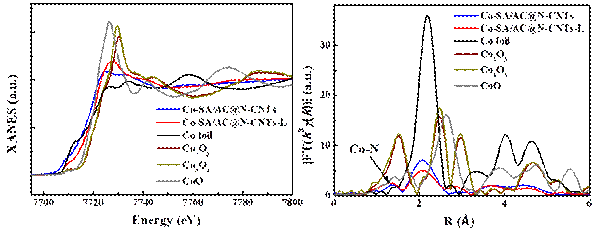| A Laser Irradiation in Liquid Approach Capable of Unlocking the Confined Co-Nx Active Sites |
| From: PublishDate:2020-07-29 Hits: |
The selective hydrogenation of quinoline and its derivatives is an important means to produce corresponding 1,2,3,4-tetrahydroquinolines for pharmaceuticals, agrochemicals and other applications. The most of high performance heterogeneous catalysts for hydrogenation of quinolines are precious metal-based catalysts, however, their selectivities are insufficient. Additionally, the scarcity and high cost of such precious metal catalysts limit their practical applications. Recently, scientists of Environmental and Energy Nanomaterials, Institute of Solid State Physics, Chinese Academy of Sciences has made important progress in the construction of nonprecious hydrogenation catalysts with high catalytic activity, selectivity and stability. Their research has been published on December 6th, 2019 in Advanced Materials. The team speculated the presence of rich highly dispersed Co single-atoms/atom-clusters (SAs/ACs) sites confined inside the acid-leached N-doped carbon nanotubes (N-CNTs) derived from ZIF-67, nevertheless, they are catalytically inactive. Only few exposed Co SAs/ACs sites are available for the reaction, while the vast majority of Co SAs/ACs sites confined inside N-CNTs are inaccessible to the reactant. Herein, the group further demonstrated a simple and effective laser irradiation in liquid technique to expose the highly dispersed inaccessible Co SAs/ACs sites confined inside CNTs. The laser irradiation in liquid treatment is capable of not only completely destroying the dodecahedral architecture but also breaking N-CNTs structures. As a result,N-CNTs consist of a large number of broken opening structures,which will make them readily accessible by the reactants. The liberated highly dispersed Co-Nx sites display generic catalytic activity toward the selective hydrogenation of quinoline and its derivatives into corresponding 1,2,3,4-tetrahydroquinolines with almost 100% conversion and selectivity, which is much higher than that of the sample without laser irradiation.
The catalyst after laser irradiation treatment had a large number of Co SAs/ACs active sites, and the Fourier-transform EXAFS spectra confirmed that the highly dispersed Co site was the Co-N coordination type using XAFS experiments carried out at 1W1B-XAFS station of BSRF. The determination of coordination structure of highly dispersed active sites plays an important role in the recognition of real hydrogenation active sites. We used laser irradiation in liquid technique to prepare highly dispersed hydrogenation active sites, and constructed a nonprecious metal catalyst with high catalytic activity, selectivity and stability. In this work, synchrotron radiation sources provided important help for the understanding of new hydrogenation active sites. The reported approach in this work is widely applicable to unlock the catalytic powers of the inaccessible catalytic active sites confined by other materials. Article: Wanbing Gong, Qinglin Yuan, Chun Chen, Yang Lv, Yue Lin,* Changhao Liang, Guozhong Wang, Haimin Zhang,* and Huijun Zhao*. Liberating N-CNTs Confined Highly Dispersed Co-Nx Sites for Selective Hydrogenation of Quinolines. Adv. Mater. 2019, 1906051. |
|
|
| Chinese
- Metal-free efficient photocatalyst for stable visible water splitting——Top ten major scientific progresses in China in 2015
- The nano-resolution imaging platform was awarded the first rate prize of Beijing Science and Technology in 2014
- Beamline 1W1 of BSRF started to runoperate in the couplingparasitic mode of BEPCII
- Synthesis of High Performance Polymer Materials for Field Effect-Transistors
- Surfactant molecular aggregates in green solvents
- GIXRD has played an important role in the characterization of organic thin-film transistors
Copyright © 2011 - 2012 Beijing Synchrotron Radiation Facility


